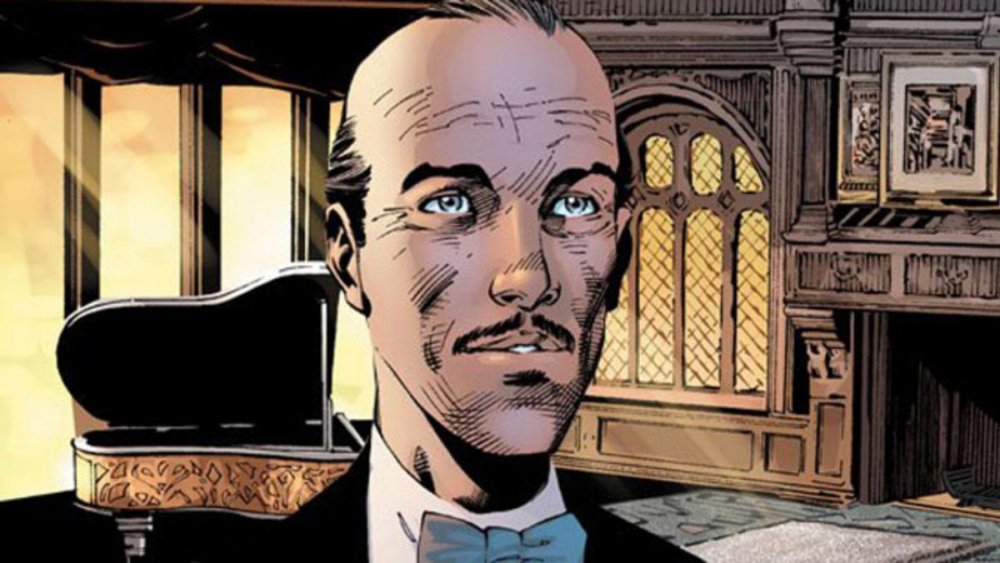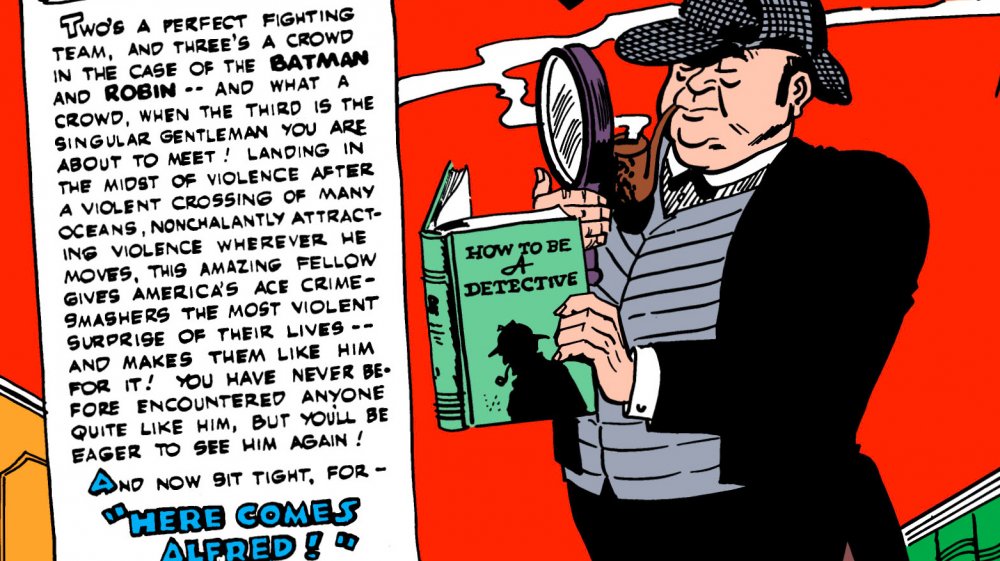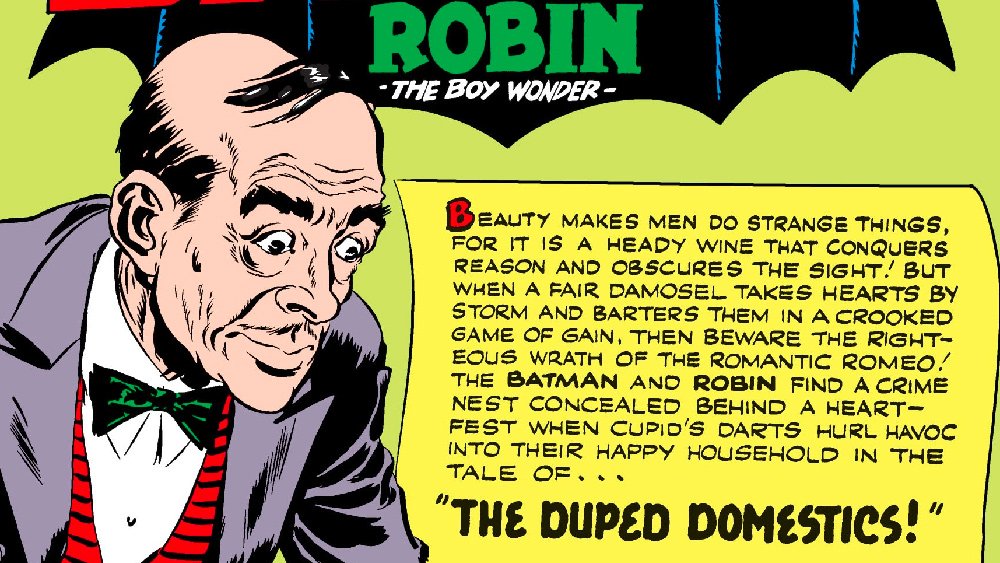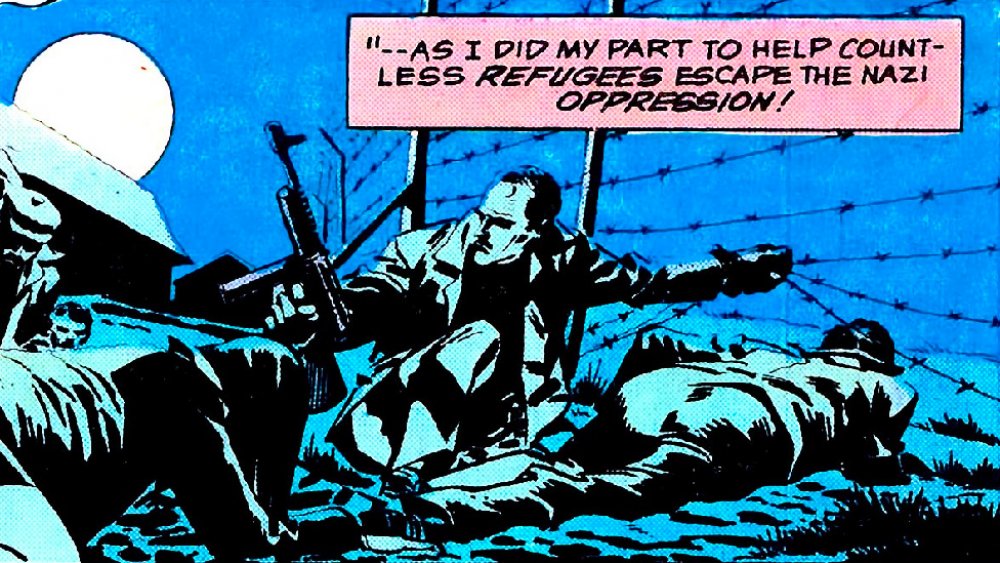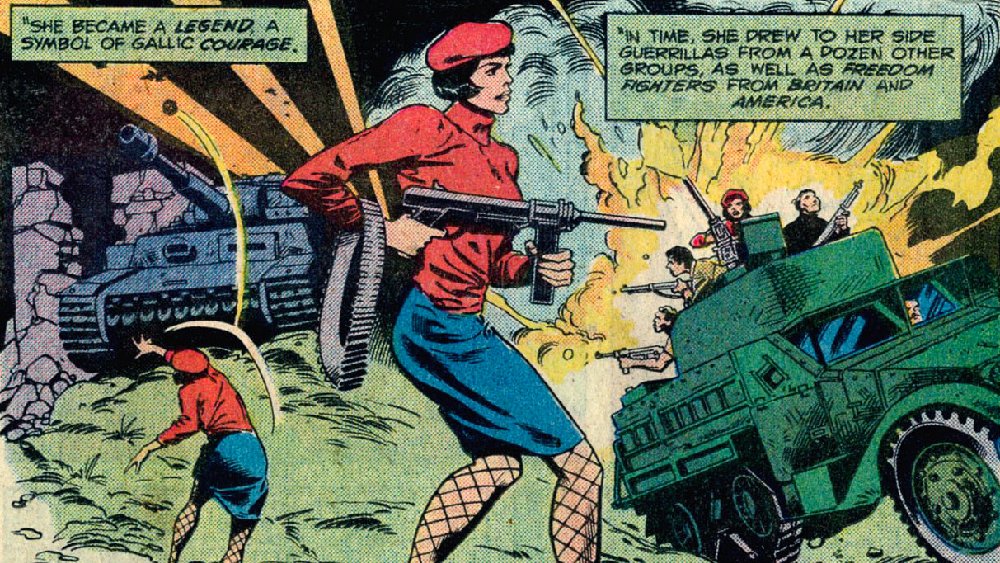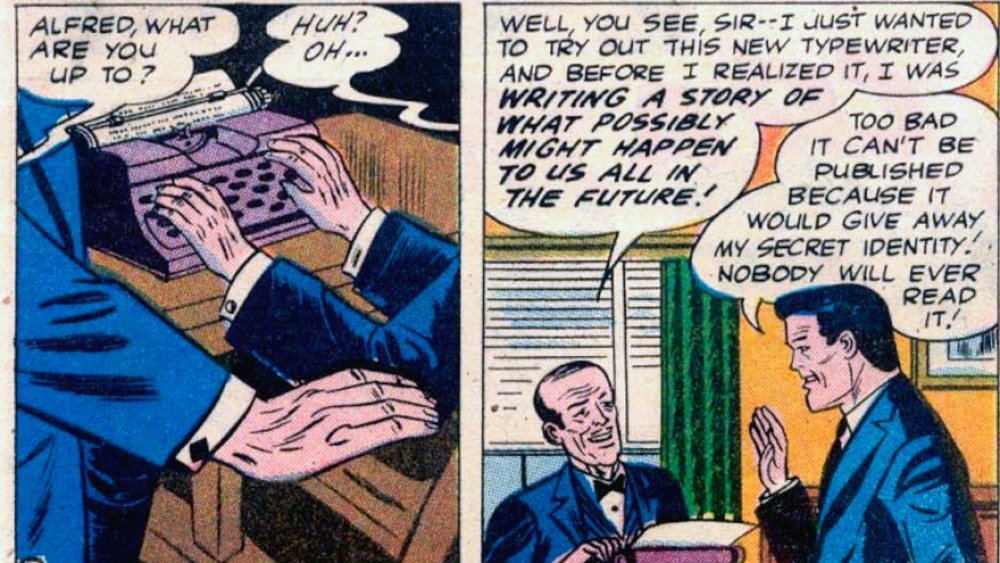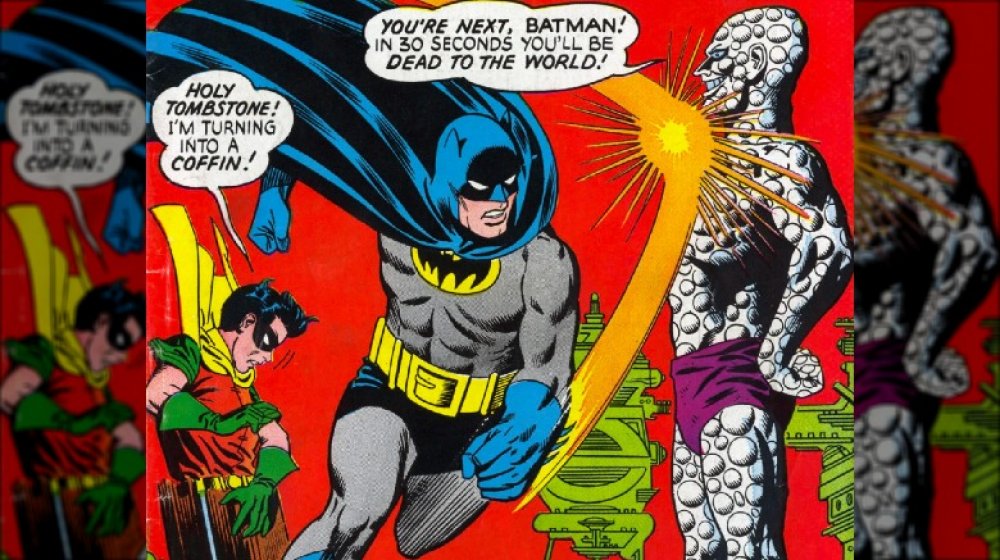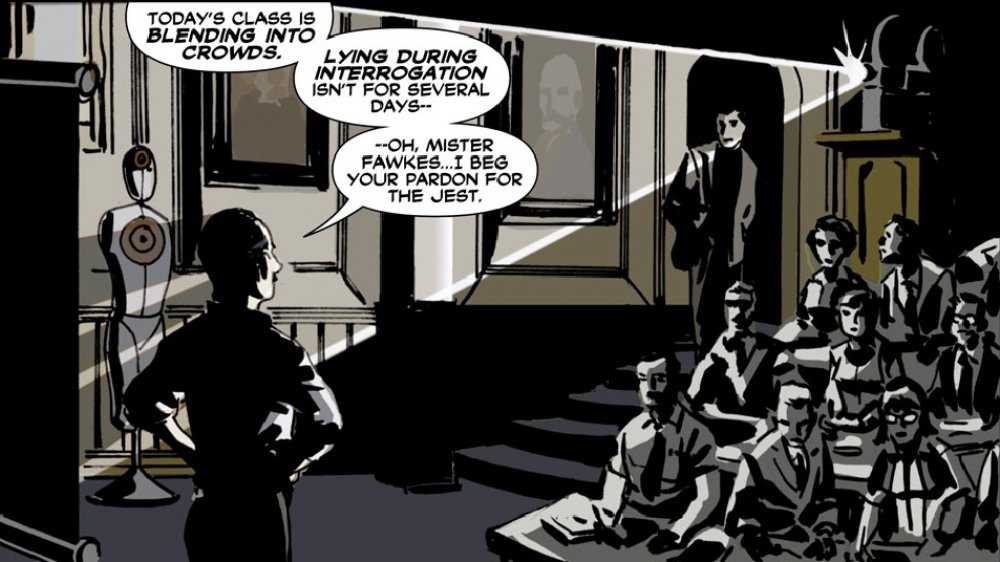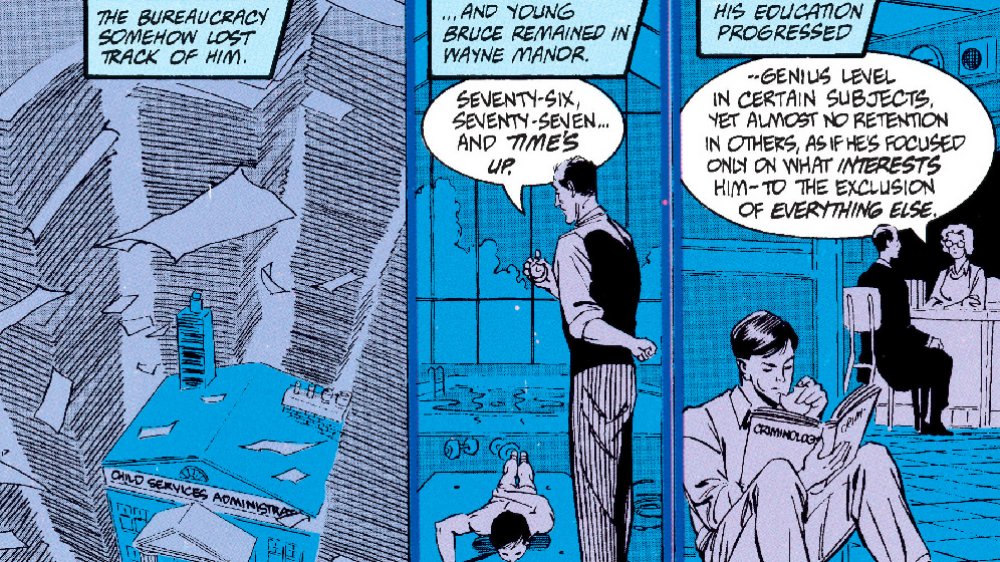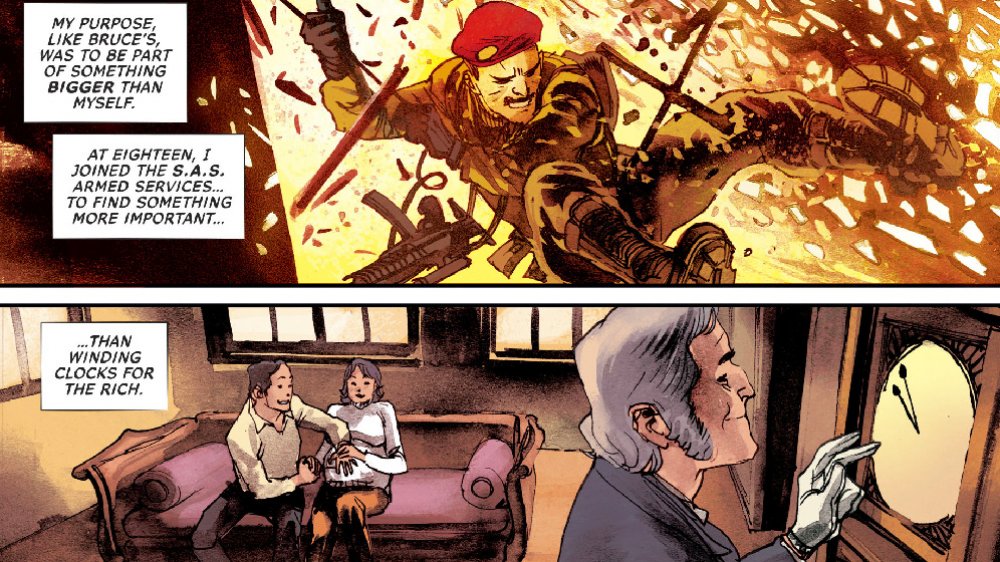Alfred Pennyworth's Entire Batman Backstory Explained
Of all of Batman's friends, allies, colleagues, and assorted hangers-on — lookin' at you here, Harold — none have been as stalwart and loyal as his butler, Alfred. While he joined the cast of the Batman titles a little bit later than Commissioner Gordon and Robin, he's evolved over the years into something much more than the bumbling valet that he was created as. He's a surrogate father for both Bruce Wayne and the entire Batman family, a trained medic whose skill is a crucial part of the Dark Knight's crime-fighting operation, and he's even the author of some pretty weird non-erotic friend fiction about his employer.
With all that prominence, though, there's been a question that's persisted for decades: What was he like in the years before he took the job as the gentleman's gentleman for Gotham City's greatest hero? There have been hints in the films and even an entire TV show devoted to exploring the misspent youth of one Alfred Thaddeus Crane Pennyworth, but the comics have gone a whole lot deeper. From his Shakespearean stage career to the shocking reveal that Alfred himself was a Dark Knight, here's the entire backstory of Batman's butler.
How Alfred met Batman
Like a lot of comic book characters, particularly at DC, Alfred's backstory is complicated by the fact that there have been multiple versions of the character with some pretty drastic differences. The original version, though, was way more straightforward, even if he's hardly recognizable as the character we know today — and not just because he's a bit thicker around the middle.
He made his first appearance in Batman #16 — hitting shelves almost exactly four years after the Caped Crusader himself — which declared on the cover that someone would learn Batman and Robin's true identities. Considering that the lead story in that issue was about the Joker, that promise probably had a few readers at least a little worried, but they shouldn't have been. The identity-learner in question was, of course, Alfred, and rather than being a harrowing tale of danger, it was mostly a comedy.
In the appropriately titled "Here Comes Alfred," Bruce Wayne's newest employee is a bumbling goofball, to the point where he arrives a) without actually being hired by the person for whom he intends to buttle and b) a full two years late. The latter is actually pretty understandable — it's 1943, and Alfred blames the long delay on the war — but Bruce not actually wanting a butler isn't really a concern for Big Al. Instead, he's there at the request of his father, Jarvis, who'd been Thomas and Martha Wayne's butler before, well, you know. Alfred had always had dreams of being an actor. But on Jarvis' deathbed, he asked his son to carry on the family business, so Alfred stepped away from the spotlight, hopped a two-year cruise to Gotham, and promptly discovered quite by accident that he actually was working for Batman.
Alfred's look and accent would be refined — the original version was written with a working-class British accent rather than the posh formality that would come later, not unlike the one we'd get from Michael Caine in the Dark Knight trilogy — but many other elements stuck around. The familial connection to the Waynes, the history as an actor, and his not-so-secret desire to become a detective himself would all be a part of the character going forward.
How Alfred got his new look
After a year's worth of bumbling his way through the Caped Crusaders' adventures, Alfred got a pretty significant redesign in 1944. The in-story reason was that Alfred went off to a health resort after feeling that he "lacked a certain dash and elegance that would enhance [his] value as [Batman's] crime-fighting assistant." The real reason, however, came in an attempt to cash in on a little bit of cross-media success.
At the time, the Batman serials were doing pretty well in the movie theaters, despite being extremely terrible. The comics decided to bring a few things over to draw the same audience, much in the same way that the Superman comics had imported Kryptonite after it had been introduced on the radio show. The most notable element to jump from the screen to the page was probably the Batcave, but actor William Austin wound up having a greater impact on the Batman legacy than anyone could've expected.
Austin played Alfred on the screen, and like his comic book counterpart, he was the bumbling comic relief for Batman's adventure against the evil Dr. Daka and his army of zombies. Unlike the comic book Alfred, though, Austin was a thin, mustachioed man who would look very familiar to modern readers. So comics Alfred got a redesign to bring him into step with Austin, and despite being portrayed by a handful of actors in films that were far more successful than the serials, the look stuck. But now that Alfred had his new look, it was time to really make things complicated.
He was basically James Bond during World War II
The Silver Age version of Alfred had a significantly harder edge to him than the comedy sidekick of the Golden Age. For one thing, while he retained the eagerness to help out with Batman and Robin's crimefighting, he was no longer characterized as the bumbling butler that he'd been. And that makes sense. By the 1950s, Batman was well on his way to becoming a guy who was basically just the best at everything, so his butler should probably be pretty good at his job, too. As a result, his long-established skill with acting became an occasional tool for Batman when he needed someone to go undercover for a quick bit of information.
Alfred's backstory got an upgrade, as well. Rather than just going straight from an accomplished stage career to domestic service, the Silver Age Alfred was depicted as having fought in World War II. He wasn't the average infantryman, either. He was a full-on Bond. In addition to working for British intelligence, he was shown in Untold Legend of the Batman as being behind enemy lines, freeing prisoners from Nazi concentration camps, and mowing down soldiers with a machine gun. Clearly, he did not — and still does not — share his employer's aversion to firearms.
After his service in the war, as he says himself, Alfred "put away [his] weapons and returned to [his] one true love — the stage!" And that was pretty much that. Perhaps surprisingly, Alfred's past as a Nazi-hunting commando spy didn't actually come up that often in the comics. Aside from a few mentions, it was mostly treated as though it was just the job he'd had before he promised his father to take up the family business as a butler for the Waynes. There was, however, one major exception.
Alfred Pennyworth's tragic love story
Combat wasn't the only thing that Alfred found on the battlefields of World War II. He also found a tragic love with Mademoiselle Marie.
While she never had her own series like Sgt. Rock or the Blackhawks — or even the featured appearances of G.I. Robot, the robot that was also a soldier — Mademoiselle Marie was one of the most prominent characters in DC's line of war comics. As her name implies, she was a fighter in the French Resistance and also a woman. That was pretty much all there was to her, aside from the fact that she did all of her freedom fighting while wearing the stereotypically French ensemble, right down to a beret and fishnet stockings. In 1943, she met Alfred while he was fighting alongside the Resistance in occupied France. The two of them fell in love, and as Alfred would later say, "I would have married Marie if the war hadn't forced us apart."
Sadly, Mademoiselle Marie wouldn't live to become Madame Pennyworth — and Bruce Wayne wouldn't get a badass French Resistance fighter as a surrogate mom — but their time together had a lasting result. Marie gave birth to their daughter, Julia, shortly before her death, with Alfred only finding out about her years later. While he sent money to Julia's adopted father, Jacques Remarque, to support his daughter, Alfred's guilt over not being there for her in her youth led him to keep his parentage a secret, even from Batman. Julia, however, had the same knack for discovering the truth that her father did. Not long after meeting him for the first time — and accusing him of murdering Mademoiselle Marie, a crime that we should probably note Alfred did not, in fact, commit — she figured things out for herself. Towards the end of the Silver Age, Julia would move into Wayne Manor, and it probably won't surprise you that she eventually got caught up in some supervillain plots.
Alfred's weird habit of writing fan fiction
With his bold statement that acting was his "true love" — or at least a job he liked more than dusting off a giant penny and a robot dinosaur in a cave full of flying rodents known primarily for drinking blood and the size of their droppings — you might be wondering how Alfred coped. Well, don't worry. His days weren't entirely occupied with mending utility belts and cooking dinner for the whole Justice League on about ten minute's notice. He was able to find an outlet for his creativity off the stage by writing elaborate fan fiction about his boss.
You know, a completely normal thing to do, even in the DC Universe.
This was mainly a framing device for the kind of "imaginary stories" that were common in the Silver Age, like catching a glimpse of what it would be like for Batman's children to take over for him after his retirement. The weird thing is, these stories didn't actually need that framing device. There were plenty of "imaginary stories" in the Superman books (aren't they all?) that didn't involve Jimmy Olsen posting them to AO3 or whatever. Sometime in 1960, Batman co-creator Bill Finger just looked at Alfred and thought, "That guy probably writes elaborate fantasies about people he knows in real life."
Weirdly enough, Alfred's knack for friend fiction survived into the modern age comics, just like Julia and his past as a highly trained commando. Rest assured however, that it doesn't come up that often.
That time he turned into a supervillain
This next part may not qualify as part of his backstory since it happened well after he entered Bruce Wayne's service. That said, no look at Alfred's history would be complete without a mention of the time that he died and was then resurrected as a superpowered mutant villain called the Outsider who spent over two years trying to kill Batman and Robin before they dosed him with enough radiation to turn him good again.
That pretty much covers the entire saga, but there are a lot of interesting implications that the comics never really dug into, and the main one is that there's a strong possibility that the Outsider was part of Alfred all along. Not the part where he looks like man-shaped stack of ping-pong balls in what's essentially a purple diaper. The part where there's the vicious intelligence of a criminal mastermind and a deep hatred for authority figures lurking behind the posh facade.
This is supported by the fact that at one point, 20 years after the original story, Alfred is transformed into the Outsider once again, proving that it wasn't just that initial shot of radiation that turned him evil. That actually does gel pretty well with what we already knew about Alfred's backstory in the Silver Age, though. He's a peaceful man with some John Wick-ian violence in his past, an actor who threw himself into his roles, and a man who never wanted to be a servant who felt forced into it by his binding sense of duty. Looking back, it's not difficult to tie all of that together into the Outsider. Considering how many Batman stories from the past 40 years have been built around themes of duality and the darkness within, it's pretty surprising that this particular aspect was never brought up in detail.
Alfred's past gets revised
After the DC Universe was rebooted in 1987 following the events of Crisis on Infinite Earths, Alfred's backstory got another revision. Tonally speaking, this went hand-in-hand with the grittier Batman origin that fans saw in Frank Miller and David Mazzucchelli's Batman: Year One, and in fact, the first big change came in that book. While Alfred had always had an interesting personality that served as a foil for Bruce Wayne's, Year One's version reinvented him as the snarky, nagging father figure whose dry wit was there to take his extremely serious boss down a peg. Year One also characterized him as not just a former soldier but one with "training in combat medicine," giving Batman someone who could stitch him up now that the grittier faux-realism was leading to more serious injuries.
It's worth noting that Alfred's combat expertise was downplayed significantly in this version. He was far more capable than the average butler — although to be fair, we're not really sure how good the average butler is at the martial arts — and his military specialty was as a medic and instructor.
This also hinted at the differences in his past. This version of Alfred was revealed to have been born "Alfred Beagle," reviving a name the character had briefly gone by in the Golden Age. After a successful career as an actor, he signed up with Britain's MI5 during the Cold War, training spies in the fine art of deception. It was only after he had an unfortunate run-in with some Russian superheroes that he moved to America and changed his name to "Pennyworth," fulfilling his late father's request of buttling for the Waynes. His intent was for this to be a temporary situation until things cooled off back home, but he took a liking to the family, especially their young son Bruce, who would soon be in need of a father figure to fill a tragically vacated position.
How he became Batman's father figure
One of the more interesting quirks of the post-Crisis Batman story came from the elimination of any other Waynes who'd been lurking around in the Silver Age. Much in the same way that the Superman story had eliminated characters like Supergirl, Krypto, and the Bottle City of Kandor to emphasize his status as the "Last Son of Krypton," Bruce Wayne being isolated and alone after the death of his parents was made more central to the character.
Unfortunately, this left a pretty big hole in Bruce's past, and it raised the question of just who raised this kid after the ill-fated walk down Crime Alley. In the Silver Age, that role had fallen to the relatively obscure Philip Wayne, Thomas' brother. That's right, much like the Fresh Prince, Batman also moved in with Uncle Phil. But in the new version, Bruce was the last of the line. As unlikely as it was, readers could buy that the youngest son of two East Coast old-money families (Martha Kane had her own fortune before marrying into the Waynes) had exactly zero other relatives. Asking us to believe that a ten year-old with infinite money was allowed to just fend for himself, however, was pushing it, even in a world with Green Lantern.
Thus, the job fell to the character who was already in the role of Batman's surrogate father: Alfred Pennyworth. Thanks to some well-placed bribes from a surprisingly devious tween Bruce, Alfred was given custody of the recently orphaned billionaire, fulfilling the ultimate childhood fantasy of having a dad who you could boss around because he was technically also your employee. Alfred was the one who accompanied Bruce on his trips around the world to learn all of his crime-fighting skills, and that was a satisfactory enough answer that nobody ever stopped for a second and said, "Wait, they gave custody to the butler?"
Alfred Pennyworth was once a Dark Knight
The current version of Alfred, rebooted once again in 2011, is a synthesis of pieces from the past incarnations. Like the post-Crisis Alfred, he thinks of Bruce as a son, and like the Silver Age version, he has a daughter of his own — although this Julia Pennyworth is well aware of who her father is, and she followed him into the UK's special forces before filling in for him in the Batcave. He also has the intense military past that we saw back in the '70s and '80s, but this time, it's not tied to the real-world conflict of World War II. Instead, it's the kind of wild ride you can only get from comics.
This Alfred's youth in London was marked by an intense resentment of his father for taking a job across an ocean "winding clocks for rich people." As a leather-jacketed '80s punk, complete with mohawk, he got in trouble with the law several times for various petty crimes, including tagging the city's rooftops with the symbol of a shattered clock. He found a more constructive outlet when he discovered acting, but his youthful rebellion ultimately led him to join the army at 18, where he quickly rose up the ranks of the SAS.
It was while he was there, having proven himself as an exceptional sniper and counter-terrorist operative, that he was recruited for one of the DC Universe's many shadowy black ops programs. This one, however, had the distinction of dating back about a thousand years. Codenamed the Nemesis Program, the group was rooted in the idea of a kingdom having a soldier or, originally, a knight who operated in secret, with full deniability from the crown. Officially branded a traitor, this — wait for it — "Dark Knight" would do the dirtiest of the dirty work, completely alone other than a handler as his "squire." Alfred was tapped for the job by the squire, codenamed Briar, and trained for a year before learning that Briar was less of a soldier and more of an unhinged madman driven to extremes by the death of the previous Dark Knight, his son, and who was planning to murder Alfred's dad to sever his ties to anything other than the program.
Needless to say, Alfred quit and went off into the rewarding world of buttling for the Waynes. Briar, however, not only survived after his battle with Alfred, but he didn't give up on his goal of turning Alfred into the perfect soldier. If he couldn't make Alfred into the Dark Knight, he'd just clone him and spend the next 25 years or so raising him completely without humanity to be the ultimate killing machine. You know, normal stuff to have in your past when you go to work for Batman.
